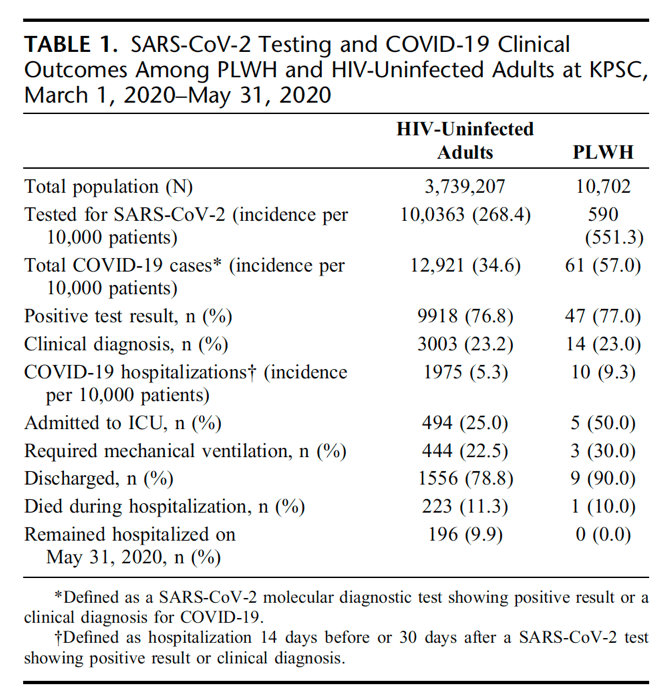| |
PLWH Have Higher COVID Testing, Diagnosis &
Hospitalization at Kaiser Permanente So. Calif.
|
| |
| |
Download the PDF here
the incidence of testing, diagnosis, and hospitalization for COVID-19 was higher in PLWH at Kaiser Permanente Southern California. In this cohort of PLWH with largely well-controlled HIV, we found that both incidence of testing and incidence of diagnosed COVID-19 were higher in PLWH than in HIV-uninfected patients. Hospitalizations were observed to be proportionally higher in PLWH than in HIV-uninfected patients in our study sample....you can see in table 2 56% to 59% in this analysis are Hispanic in both HIV+ & the HIV-uninfected groups, 6.8% to 9.9% Black, 14-15% white. In this study, we have described the incidence of testing, diagnosis, and hospitalization for COVID-19 among PLWH and HIV-uninfected patients in a large integrated health care system in California. kaiser-permanent. In this population of patients with well-controlled HIV, the incidence of COVID-19, hospitalization, and need for ICU level care as a measure of severity was higher in PLWH than in HIV-uninfected individuals. Comorbidities did not differ significantly between PLWH and HIV-uninfected populations, although PLWH were significantly younger than HIV-uninfected patients with COVID-19. .....We found a higher incidence of testing ordered for PLWH (551 per 10,000 patients) than that for HIV-uninfected patients (268 per 10,000 patients). This may be attributed to PLWH being designated as a potential risk group at KPSC during the study period, where prioritization for testing was given to patients in vulnerable populations, including HIV, organ transplantation, pregnancy, malignancy, or elderly populations.....Incidence of COVID-19 disease in this study was 57.0 per 10,000 PLWH and 34.6 per 10,000 HIV-uninfected individuals or a 1.6-times higher incidence of COVID-19 in PLWH. The underlying study population included 10,702 PLWH and 3,739,207 HIV-uninfected individuals (Table 1) who were KPSC health plan members between March 1, 2020, and May 31, 2020. Incidence of SARS-CoV-2 molecular testing, COVID-19 diagnosis, and COVID-19 hospitalization was 551.2, 57.0, and 9.3 per 10,000 PLWH compared with 268.4, 34.6, and 5.3 per 10,000 HIV-uninfected individuals, respectively.. It is possible that COVID-19 was underdiagnosed in HIV-uninfected populations because mildly symptomatic patients who were HIV-uninfected without other risk may not have been tested in the early months of the pandemic to conserve testing supplies and prioritize testing for critically ill patients. In addition, a higher incidence of COVID-19 disease in PLWH may also have been attributed to home, community, or occupational risk factors not examined in the HIV-uninfected population.....PLWH in general experience a greater risk of multiple comorbidities associated with aging than HIV-uninfected patients.20 In our study, prevalence of comorbidities was similar between groups in both hospitalized and nonhospitalized patients perhaps because a greater proportion of HIV-uninfected patients were older than PLWH. In addition, obesity is a significant risk factor of poorer outcomes associated with COVID-19.4 PLWH in this sample were significantly less obese than HIV-uninfected patients (Table 2), which may have been a protective factor.....In the United States, only 62.7% of all PLWH are virally suppressed, as defined by an HIV viral load of <200 copies/mL.22 As such, our findings may not be generalizable to all PLWH because both hospitalized and nonhospitalized PLWH in our study exhibited >95% virologic suppression, with very few cases where CD4+ counts were ≤200 cells/mm3.

Brief Report: COVID-19 Testing, Characteristics, and Outcomes Among People Living With HIV in an Integrated Health System
JAIDS Sept 1 2021
Abstract
Background:
Understanding the attributes of COVID-19 clinical severity among people living with HIV (PLWH) compared with those in HIV-uninfected patients is critical for risk stratification and treatment strategies.
Methods:
We conducted a retrospective study at Kaiser Permanente Southern California among PLWH aged 18 years or older. We compared the incidence of SARS-CoV-2 molecular testing, COVID-19 diagnosis, and COVID-19 hospitalization among PLWH and HIV-uninfected adults. A chart review was conducted for PLWH with COVID-19 to examine viral suppression of HIV and most recent CD4+ counts in the year before COVID-19 diagnosis, known exposures to COVID-19, and clinical presentation.
Results:
Between March 1, 2020, and May 31, 2020, the incidence of SARS-CoV-2 molecular testing, COVID-19 diagnosis, and COVID-19 hospitalization was 551.2, 57.0, and 9.3 per 10,000 PLWH, respectively, compared with 268.4, 34.6, and 5.3 per 10,000 HIV-uninfected individuals, respectively. Among those with COVID-19, the distribution of race/ethnicity, smoking status, and comorbidities was similar in PLWH and HIV-uninfected patients; however, PLWH were mostly men, younger, and less obese than HIV-uninfected individuals. Health care utilization regarding emergency care and hospitalizations in the year before COVID-19-related hospitalization was similar between the groups. Overall, HIV was virologically suppressed in >95% of PLWH with COVID-19, and HIV viral load and CD4+ status did not differ between hospitalized and nonhospitalized patients.
Conclusions:
In this population of patients with well-controlled HIV infection, the incidence of testing, diagnosis, and hospitalization for COVID-19 was higher in PLWH than that in HIV-uninfected patients.
|
|
| |
| |
|
|
|